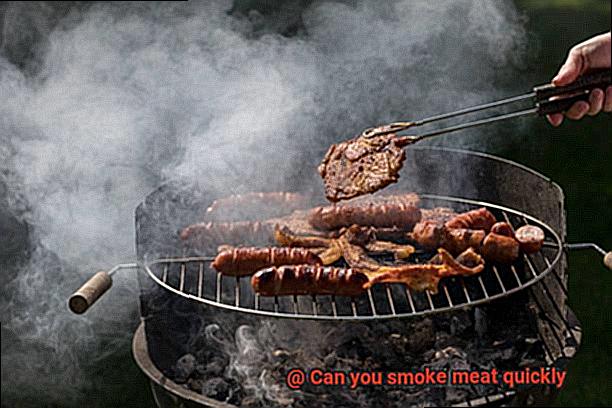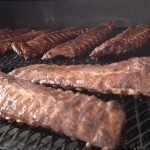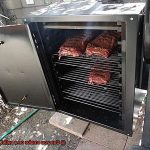Picture this: the smell of perfectly smoked meat wafting through the air, the tender texture melting in your mouth, and the complex flavors leaving you craving more. It’s a culinary experience like no other. But what if you don’t have hours to devote to slow-cooking your meat? Can you still achieve that same deliciousness in a shorter amount of time? The answer is yes, my friend.
In this post, we’re delving into the art of smoking meat quickly. Whether you’re a seasoned BBQ pro or a newbie grill enthusiast, we’ve got tips and tricks to help you create mouthwatering meals in less time. We’ll cover everything from equipment and techniques to choosing the right cut of meat.
First things first: let’s talk about selecting the right cut of meat for quick smoking. Not all cuts are created equal when it comes to speedy cooking, so we’ll highlight some top choices. Then we’ll dive into the various types of smokers and grills that work well for fast smoking – think electric smokers and charcoal grills.
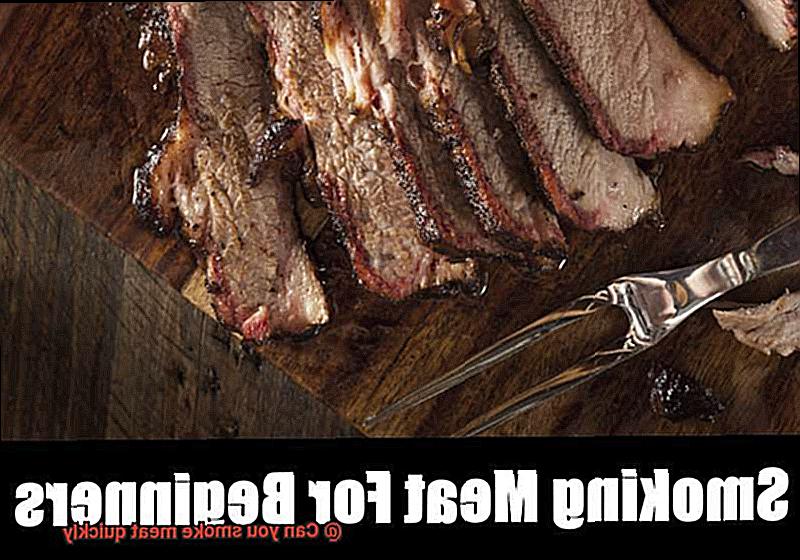
But technique is key when it comes to quick smoking. We’ll give you all the details on creating an irresistible rub, maintaining consistent temperature, and achieving that perfect smoke flavor in record time.
So, get ready to fire up your grill and learn how to smoke meat quickly like a pro.
Contents
Types of Meats to Smoke Quickly
Smoking meat is a time-honored tradition that has been passed down through generations. However, sometimes you’re short on time and want to enjoy the flavors of smoked meat without waiting all day. Fortunately, there are certain types of meats that lend themselves well to quick smoking. Here are five options to consider:
Chicken
When it comes to quick smoking, chicken is a top pick. Chicken breasts, thighs, and wings are all lean cuts of meat that can handle higher cooking temperatures without drying out. For added flavor, you can marinate the chicken beforehand or season it with a dry rub.
Pork tenderloin
Pork tenderloin is another great option for quick smoking. It’s a lean cut of meat that can be flavored in a variety of ways, making it a versatile choice. To smoke pork tenderloin quickly, cook it at around 350 degrees Fahrenheit for 1-2 hours until it reaches an internal temperature of 145 degrees Fahrenheit.
Fish
If you’re looking for a quick and healthy option, consider smoking fish. Salmon, trout, and tilapia are all good choices for smoking and can be cooked in as little as 20-30 minutes at higher temperatures of around 275-300 degrees Fahrenheit. To enhance the flavor, use wood chips that pair well with the natural flavors of the fish.
Turkey breast
Turkey breast is another lean cut of meat that cooks quickly in the smoker. It’s also a healthier option than other types of meat, making it ideal for those who are watching their calorie intake. Cook turkey breast at around 350 degrees Fahrenheit until it reaches an internal temperature of 165 degrees Fahrenheit.
Sausages
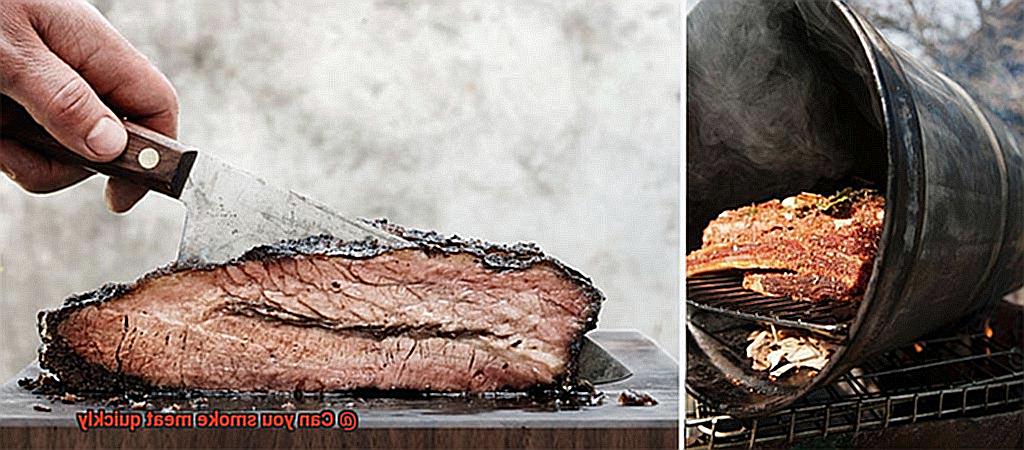
Precooked sausages are already fully cooked, making them an excellent option for quick smoking. Smoke them for just a short amount of time to infuse them with flavor and give them that smoky taste.
When it comes to quick smoking, it’s essential to select cuts of meat that are thin and can handle higher cooking temperatures without drying out. By choosing the right types of meats and using proper techniques and seasonings, you can create savory and tender smoked dishes in a shorter amount of time.
Temperature Considerations for Quick Meat Smoking
Quick meat smoking is the answer to your cravings. However, hold on before you start, temperature considerations are crucial to achieving mouth-watering results in no time.
Quick smoking involves smoking meat at high temperatures for a shorter period. But beware, smoking meat too quickly can result in dry, tough, and flavorless results. Thus, maintaining a consistent temperature throughout the smoking process is critical.
To achieve tender and flavorful results, the ideal temperature range for quick smoking meat is between 225-250°F. This range allows for a shorter cooking time while still preserving the meat’s juicy goodness. But how do we maintain a consistent temperature? The solution is by using a digital thermometer. This tool enables us to monitor the temperature of the meat throughout the smoking process and adjust the heat source accordingly.
Another vital factor to consider when quick smoking is the type of wood used. Hardwoods such as hickory, oak, and mesquite are ideal for quick smoking because they burn hotter and faster than softwoods like pine or cedar. However, it’s essential to remember that different types of meat require different cooking times and temperatures.
For example, poultry should be cooked at a higher temperature than beef or pork to ensure safe consumption. Therefore, researching the specific cooking requirements for the type of meat you plan to smoke quickly is essential.
Hot and Fast Method for Quick Meat Smoking
This increasingly popular technique involves smoking meat at a higher temperature than traditional methods, resulting in juicy and tender meat that’s ready in just 2-3 hours.
But why choose the hot and fast method? For starters, this method produces mouth-watering results thanks to the high temperature that causes the fat to render out, keeping the meat moist and flavorful. Plus, it’s versatile enough to be used for a variety of meats including beef, pork, chicken, and fish. And for those who don’t have hours to spare or need to smoke meat on short notice, the quick turnaround time is a major advantage.
Of course, there are some challenges to using the hot and fast method. The high heat can cause the meat to cook faster than expected, making it important to keep a close eye on your smoker and meat to ensure even cooking. Additionally, you may need to add more wood chips or charcoal to your smoker as the heat will cause them to burn faster.
To use this method effectively, preheat your smoker to a temperature between 275-300 degrees Fahrenheit. Once you’ve added your meat, check the internal temperature periodically to ensure it’s cooking evenly. With practice and attention, you’ll be able to produce flavorful and juicy meat in just a few hours.
Reverse Sear Method for Quick Meat Smoking
The reverse sear method for quick meat smoking is your answer. This technique has been gaining popularity among grill masters and foodies alike, and it’s not hard to see why.
To start, season your meat with your preferred spices and herbs. Preheat your grill or smoker to a low temperature of about 225-250°F, then place the meat on the grill and let it smoke for several hours until it reaches the desired internal temperature. This cooking process can take between 1-3 hours depending on the size and thickness of the meat.
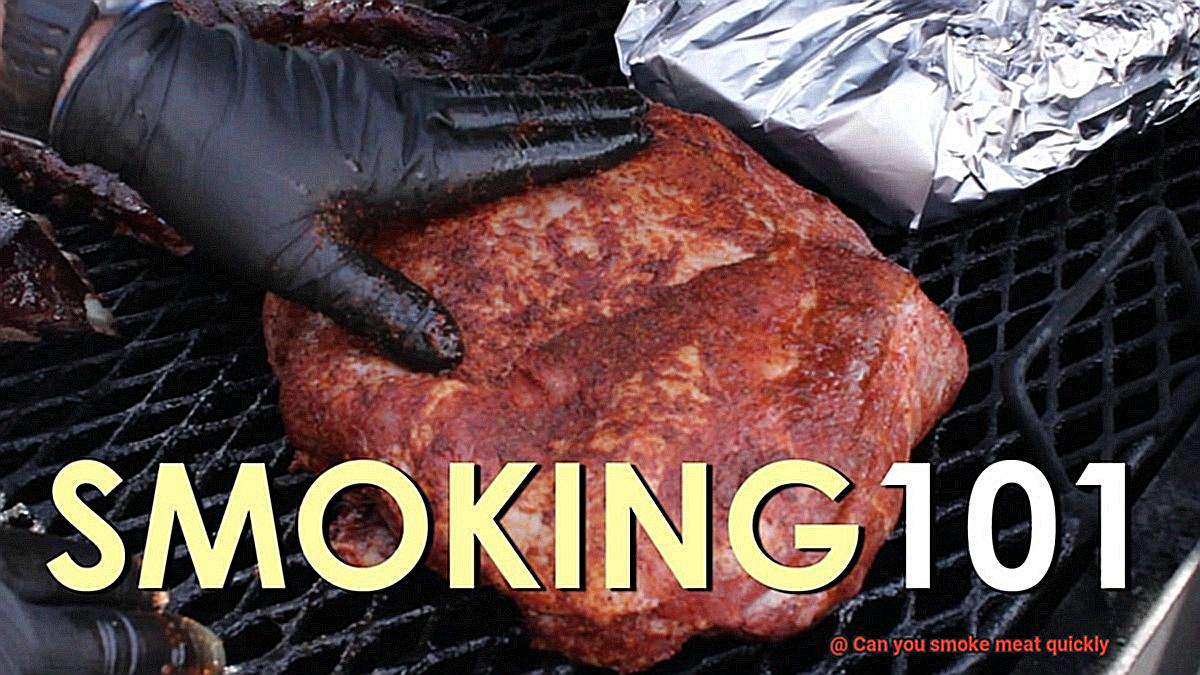
After your meat has reached the perfect internal temperature, remove it from the grill and let it rest for 10-15 minutes. Meanwhile, crank up the heat on your grill or smoker to high heat (around 500°F) in preparation for the sear. If desired, you can also baste your meat with a glaze or sauce during this time.
Once your grill has reached high heat, place your meat back on the grill and sear each side for 1-2 minutes until a delicious crust forms. The reverse sear method provides a wonderful charred flavor and texture while keeping the meat tender and juicy inside.
Tips for Smoker Maintenance
If you’re a fan of smoked meat, you know that it’s not just about the ingredients and the cooking process, but also about the condition of your smoker. Regular maintenance and care are key to ensuring that your smoker is functioning properly and producing the best possible results. Here are some essential tips for smoker maintenance:
Keep Your Smoker Clean:
A clean smoker is essential for producing high-quality smoked meat. Make sure you remove any ash, grease, or debris from your smoker after each use. Cleaning the smoker racks and grates is also important to prevent any buildup of food residue that could affect the taste of your smoked meat.
Check and Replace Worn-Out Parts:
Your smoker has various parts such as gaskets, seals, and temperature probes that can wear out over time. It’s important to regularly check these parts and replace them if necessary to ensure that your smoker is functioning properly and to avoid any potential issues that could slow down the cooking process.
Properly Season Your Smoker:
Seasoning your smoker involves coating the inside with oil or fat and then heating it up to a high temperature for a short period of time. This process helps prevent rust and ensures that your smoker is ready to produce consistently high-quality smoked meat.
Store Your Smoker Properly:
If you’re not using your smoker regularly, make sure to store it in a dry place and cover it with a waterproof cover to protect it from the elements. Proper storage will help prolong the life of your smoker and keep it in top condition.
Monitor Temperature Control:
Temperature control is crucial when smoking meat quickly. Make sure to monitor the temperature inside your smoker regularly and adjust accordingly. If you notice any issues with temperature control, check for any potential blockages or worn-out parts that may be affecting the performance of your smoker.
Pros and Cons of Quick Meat Smoking
Look no further than quick meat smoking. However, before you dive in, let’s examine the pros and cons of this popular method.
Pros:
- Reduced cooking time: Quick meat smoking involves short cooking times at high temperatures, which means you can have delicious smoked meat on your plate in half the time.
- Experimentation with flavors: Since the cooking time is shorter, you can try out different wood chips or rubs without committing to a long smoking process. This allows for more variety and experimentation in the kitchen.
Cons:
- Dry and tough meat: The higher temperatures used in quick smoking methods increase the risk of overcooking and drying out your meat. This can result in a tough and chewy texture that’s unappetizing.
- Lack of depth in flavor: Traditional smoking methods involve slow-cooking meats over several hours, allowing for a deep penetration of smoky flavor. Quick smoking methods may not allow for this same depth of flavor, resulting in a less robust taste.
Ultimately, the decision to use quick meat smoking depends on your preferences and time constraints. While it can save you time and allow for experimentation with different flavors, it may also sacrifice some depth of flavor and texture. It’s important to weigh these pros and cons before deciding on a smoking method that works best for you.
Different Ways to Flavor Your Smoked Meats
Smoking meat is an art, and the flavor is the canvas. The right combination of spices and seasonings can take your smoked meat from good to great, and there are countless ways to achieve that perfect flavor profile. Here are five different ways to flavor your smoked meats:
Dry Rub
A dry rub is a classic way to add flavor to your smoked meats. This mixture of herbs, spices, and other seasonings is rubbed onto the meat before smoking. As the meat cooks, the rub forms a flavorful crust, infusing it with delicious taste. Common ingredients in a dry rub include salt, pepper, paprika, garlic powder, onion powder, and brown sugar. To ensure that the flavors penetrate the meat, massage the rub into the meat and allow it to sit for at least an hour before smoking.
Marinade
Soaking your meat in a marinade before smoking is another way to add flavor. Marinades are typically made with an acidic base such as vinegar or citrus juice and can also contain herbs and spices. The longer you marinate your meat, the more it will absorb the flavors of the marinade. This not only adds flavor but also helps tenderize the meat, making it juicier and more delicious.
Wood Chips
The type of wood chips you use can significantly impact the flavor of your smoked meats. Different types of wood impart different flavors into the meat. For example, hickory wood creates a strong smoky flavor while fruit woods like apple and cherry create a sweeter smoke flavor. Soak your wood chips in water for at least 30 minutes before adding them to the smoker for maximum flavor infusion.
Sauces or Glazes
Adding a sauce or glaze during the last hour of smoking can add a burst of flavor to your smoked meats. A barbecue sauce or honey glaze can be applied to create a delicious crust on the meat. The sauce or glaze caramelizes on the meat, creating an irresistible flavor explosion that will have your taste buds dancing.
Spices
For those who like a little bit of heat in their smoked meats, adding hot sauce or cayenne pepper to your dry rub or marinade is an easy way to spice things up. Other unique ingredients that can add flavor and depth to your smoked meats include beer, whiskey, maple syrup, and mustard. Experiment with different combinations of spices to find your perfect flavor profile.
Common Mistakes to Avoid When Smoking Meats Quickly
Smoking meats quickly can be a bit of a challenge, especially if you’re new to the game. However, with a little bit of knowledge and practice, you can avoid some common mistakes and achieve the perfect smoked meat every time.
First and foremost, preparation is key. Before smoking your meat, make sure you season it with your favorite spices and let it marinate for a few hours. This allows the flavors to soak in and results in a more delicious end product. Additionally, keep in mind that some cuts of meat require more cooking time than others. So, it’s important to know which cuts need longer cooking times and plan accordingly.
Another critical factor to keep in mind is regulating the temperature of your smoker. Consistency is key here. If the temperature is too high, the meat will cook too quickly on the outside and remain raw on the inside. Conversely, if the temperature is too low, your meat will take longer to cook, resulting in tough and dry meat. Consider investing in a reliable thermometer to monitor the temperature and make any necessary adjustments.
Using too much fuel is another common mistake when smoking meats quickly. While it may seem logical that adding more wood or charcoal will speed up the cooking process, it can actually have adverse consequences. Excessive fuel can create extra smoke and heat that can burn or overcook your meat. So, use just enough fuel based on your smoker size and adjust as needed.
Lastly, don’t forget about resting your meat after smoking it. Allowing your meat to rest for at least 10-15 minutes before slicing or serving is crucial. This step allows the juices to redistribute throughout the meat, resulting in a more tender and juicy end product.
htaZqsnxAIY” >
Conclusion
To sum it up, smoking meat quickly is not only feasible but also a fantastic way to relish the taste of smoked meat without waiting for hours. By following proper techniques and using the right equipment, you can whip up delectable meals in less time.
Selecting the right cuts of meat, maintaining consistent temperature, and choosing the perfect wood chips are all critical factors when it comes to quick smoking. The hot and fast method and the reverse sear method are two well-known techniques that yield tender and flavorful results. However, before deciding on a smoking method that suits you best, it’s essential to weigh the pros and cons of quick smoking.
The art of flavoring your smoked meats with dry rubs, marinades, wood chips, sauces or glazes, and spices can take your smoked meat from good to great. But remember to steer clear of common mistakes such as using too much fuel or not resting your meat after smoking.
With these tips in mind, you’ll be able to create mouthwatering smoked dishes in no time.

